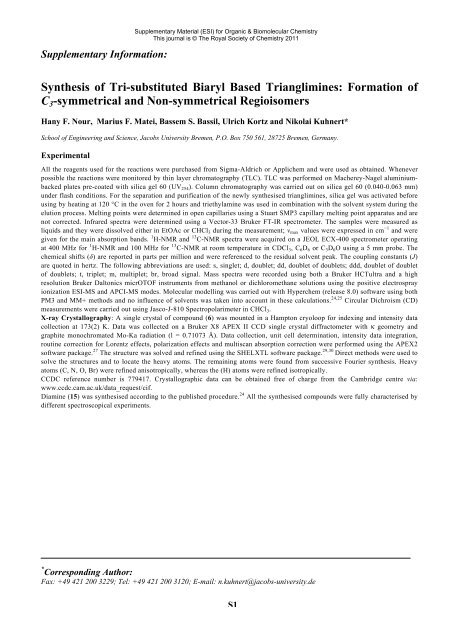The Development of Novel Antibiotics Using ... - Jacobs University
The Development of Novel Antibiotics Using ... - Jacobs University
The Development of Novel Antibiotics Using ... - Jacobs University
Create successful ePaper yourself
Turn your PDF publications into a flip-book with our unique Google optimized e-Paper software.
Supplementary Information:<br />
Supplementary Material (ESI) for Organic & Biomolecular Chemistry<br />
This journal is © <strong>The</strong> Royal Society <strong>of</strong> Chemistry 2011<br />
Synthesis <strong>of</strong> Tri-substituted Biaryl Based Trianglimines: Formation <strong>of</strong><br />
C 3 -symmetrical and Non-symmetrical Regioisomers<br />
Hany F. Nour, Marius F. Matei, Bassem S. Bassil, Ulrich Kortz and Nikolai Kuhnert*<br />
School <strong>of</strong> Engineering and Science, <strong>Jacobs</strong> <strong>University</strong> Bremen, P.O. Box 750 561, 28725 Bremen, Germany.<br />
Experimental<br />
All the reagents used for the reactions were purchased from Sigma-Aldrich or Applichem and were used as obtained. Whenever<br />
possible the reactions were monitored by thin layer chromatography (TLC). TLC was performed on Macherey-Nagel aluminiumbacked<br />
plates pre-coated with silica gel 60 (UV 254 ). Column chromatography was carried out on silica gel 60 (0.040-0.063 mm)<br />
under flash conditions. For the separation and purification <strong>of</strong> the newly synthesised trianglimines, silica gel was activated before<br />
using by heating at 120 °C in the oven for 2 hours and triethylamine was used in combination with the solvent system during the<br />
elution process. Melting points were determined in open capillaries using a Stuart SMP3 capillary melting point apparatus and are<br />
not corrected. Infrared spectra were determined using a Vector-33 Bruker FT-IR spectrometer. <strong>The</strong> samples were measured as<br />
liquids and they were dissolved either in EtOAc or CHCl 3 during the measurement; ν max values were expressed in cm −1 and were<br />
given for the main absorption bands. 1 H-NMR and 13 C-NMR spectra were acquired on a JEOL ECX-400 spectrometer operating<br />
at 400 MHz for 1 H-NMR and 100 MHz for 13 C-NMR at room temperature in CDCl 3 , C 6 D 6 or C 3 D 6 O using a 5 mm probe. <strong>The</strong><br />
chemical shifts (δ) are reported in parts per million and were referenced to the residual solvent peak. <strong>The</strong> coupling constants (J)<br />
are quoted in hertz. <strong>The</strong> following abbreviations are used: s, singlet; d, doublet; dd, doublet <strong>of</strong> doublets; ddd, doublet <strong>of</strong> doublet<br />
<strong>of</strong> doublets; t, triplet; m, multiplet; br, broad signal. Mass spectra were recorded using both a Bruker HCTultra and a high<br />
resolution Bruker Daltonics micrOTOF instruments from methanol or dichloromethane solutions using the positive electrospray<br />
ionization ESI-MS and APCI-MS modes. Molecular modelling was carried out with Hyperchem (release 8.0) s<strong>of</strong>tware using both<br />
PM3 and MM+ methods and no influence <strong>of</strong> solvents was taken into account in these calculations. 24,25 Circular Dichroism (CD)<br />
measurements were carried out using Jasco-J-810 Spectropolarimeter in CHCl 3 .<br />
X-ray Crystallography: A single crystal <strong>of</strong> compound (6) was mounted in a Hampton cryoloop for indexing and intensity data<br />
collection at 173(2) K. Data was collected on a Bruker X8 APEX II CCD single crystal diffractometer with κ geometry and<br />
graphite monochromated Mo-Ka radiation (l = 0.71073 Å). Data collection, unit cell determination, intensity data integration,<br />
routine correction for Lorentz effects, polarization effects and multiscan absorption correction were performed using the APEX2<br />
s<strong>of</strong>tware package. 27 <strong>The</strong> structure was solved and refined using the SHELXTL s<strong>of</strong>tware package. 29,30 Direct methods were used to<br />
solve the structures and to locate the heavy atoms. <strong>The</strong> remaining atoms were found from successive Fourier synthesis. Heavy<br />
atoms (C, N, O, Br) were refined anisotropically, whereas the (H) atoms were refined isotropically.<br />
CCDC reference number is 779417. Crystallographic data can be obtained free <strong>of</strong> charge from the Cambridge centre via:<br />
www.ccdc.cam.ac.uk/data_request/cif.<br />
Diamine (15) was synthesised according to the published procedure. 24 All the synthesised compounds were fully characterised by<br />
different spectroscopical experiments.<br />
* Corresponding Author:<br />
Fax: +49 421 200 3229; Tel: +49 421 200 3120; E-mail: n.kuhnert@jacobs-university.de<br />
S1

















